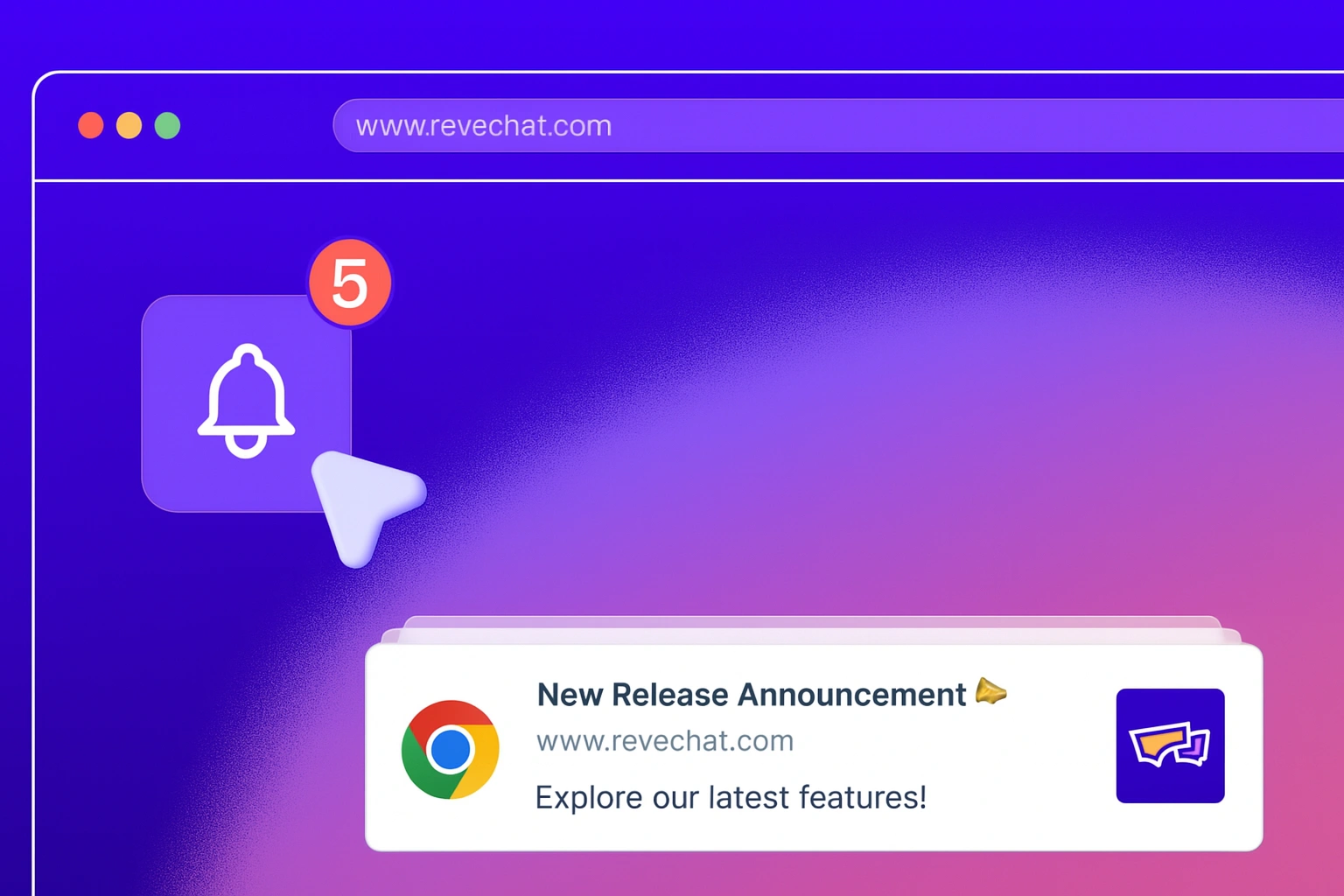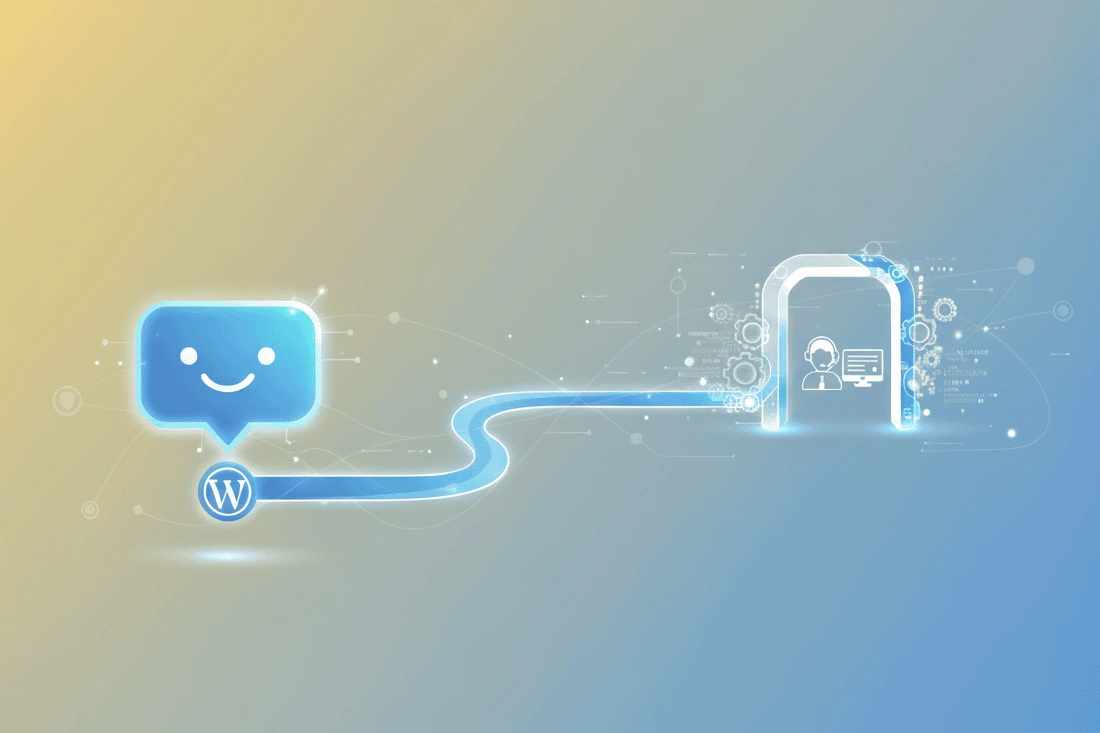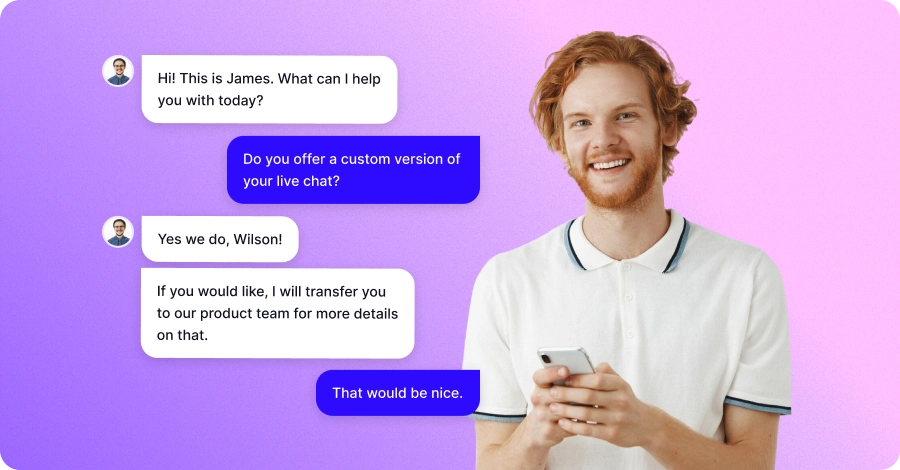Proactive Chat: Benefits, Examples, Best Practices and More
- January 27, 2021
- 10 mins read
- Listen

For any business, it is important to engage or interact with the customer even before the user is thinking of doing so. That is where proactive chat can come in as in this case, the business is taking the initiative to contact the customer.
Using live chat or chatbots, a business can send proactive messages to users and garner their attention. This improves your business so that you can grow and attract more customers that eventually increases your revenue.
So, let’s talk about proactive chats and lay out some examples, tips of how to best use them, tools, and much more.
What is Proactive Chat?
Proactive chats are essentially messages you send to customers before they start chatting with any of your agents or chatbot. The purpose of these messages is to boost conversions and entice window shoppers to buy one of your products, turning them into future loyal customers.
Contrasting Between Proactive and Reactive Chats
There are some fundamental differences between proactive and reactive chats. On one hand, reactive live chats are a way to answer customer queries and solve problems when they are the initiators.
On the flip side, proactive chat is about reaching out to customers before they approach you. That way, you are interacting with the customer before they encounter problems and in the process, show that you care about them coming to your business for solutions or products.
Basic definitions aside, here are the key differences between proactive and reactive chat.
| Proactive Chat | Reactive Chat |
|
You approach customers first |
Customers approach you first |
|
More conversions via chat |
Few conversions via chat |
|
Focuses on recommendations or assistance |
Focuses on solving issues or queries |
|
Lower chance of missing out on customers |
Higher chance of missing out on customers |
|
Can be intrusive or annoying |
Not intrusive or annoying |
While using proactive live chat can help businesses with sales and conversions, reactive chat is more about problem-solving. Thus, for a successful customer service solution, a business will need to use both systems.
As to which one to focus on more, that will largely vary from business to business, it will even differ from one industry to another. Staying on topic, let’s now discuss the various benefits of proactive chat for a business.
Benefits of Proactive Chat for Businesses
There are many benefits a business can take advantage of when using proactive messages. Here are the most prominent ones.
Elevated Customer Satisfaction
Proactive live chats are a big contributor to increasing overall customer satisfaction on your website. This is due to many reasons, the primary one being that you are messaging the customer first. By doing that, you are showing the customer that they matter and you want to offer them the best service.
So, utilizing proactive live chat, you can initiate the conversations via a chat widget, deliver personalized messages, give proper assistance and recommendations, and much more. Through all of these actions, customers feel wanted and are more likely to buy a product or service from your business.
Increased Customer Loyalty
On a different front, proactive chats also improve customer loyalty. This is a direct effect of increased customer satisfaction due to the same reason. However, they also serve recurring customers by tailoring responses based on their preferences to increase their tendency to purchase new products.
Hence, proactive chats increase customer loyalty by keeping them satisfied and offering them what they want or need.
Higher Number of Leads
Through the use of proactive chats, you interact with visitors or browsers first and increase the chances of converting them as customers. With proactive messaging, you can gauge the interest level of visitors and keep potential customers engaged, increasing the number of leads.
Boosting Sales and Revenue
Continuing from the previous point, by utilizing proactive live chats through the chat widget, you can upsell products, cross-sell items, and offer special promotions or discounts to increase purchases to the leads that you have when customers are visiting certain webpages.
This entices both new and old customers as you are recommending them products or services based on what item they are considering or past purchases. This not only boosts sales, but also increases revenue in the long run.
Reduces Bounce Rates and Cart Abandonment
By proactively messaging customers or visitors, you can significantly reduce cart abandonment and bounce rates. For ecommerce or other product/service companies, you can recommend or assist users from the get-go and increase the chances of sales, reducing cart abandonments.
This also paints an overall picture of reduced bounce rates as you are increasing customer engagement and experience, thus attracting them to what you are selling or offering. This is a massive benefit for any business selling a service or product in a competitive marketplace.
Key Proactive Chat Triggers With Examples
While proactive live chat is an excellent way to interact with customers on your website, there are some instances where you should trigger them. Here are some of those use cases with examples.
Proactive Welcome Messages
The first trigger to use proactive messages is when a new or returning visitor comes to your website or another platform. There are two different types of messages to use as labeled above and here are examples for them.
- For New Visitors: “Hi, my name is [Agent Name], how can i help you today?”
- For Recurring Customers: “Welcome back [Customer Name],what can we do for you today?”
Offering A Discount or Promotion
The second trigger is a lot more directed as enticing visitors to buy your products. This is primarily done through offering them a discount for a first purchase or giving them a promotion based on their past purchases.
- Discount: “Hi, for your first order, we would like to offer you a 20% discount. Would you like to avail this offer?”
- Promotion: “Hello [Customer Name]! Get a 10% discount today for orders above [value].”
Product or Service Recommendations
Another trigger that works really well to drive sales is to recommend items to customers and visitors. This is usually triggered when someone either searches for a product or adds one to their cart.
So to message these users, you can base them on past orders or try to upsell/cross-sell. Here are some examples of that.
- Recommending Products Based on Previous Purchase: “Hello [Customer Name], we have some new collection of shoes for the Summer season. Would you like to have a look?”
- Upselling Message: “Hi, we have noticed you added [Product A] to the cart. We have a newer model of the item available. Would you like to check that out?”
- Cross-selling Message: “Hi [Customer Name]. Other customers who have brought [Product A] have also purchased [Product B]. Would you like to learn more?”
When Users Visit Certain Pages
You can set proactive chat triggers on certain pages of your website that will send out a message to a user when they land on those pages. Here are some examples of that.
- On Pricing Page: “Hello, would you like some guidance on which plan works best for you? Let me know if you need any assistance.”
- On a Product Page: “Hi there! If you have any questions about [Product Name]—whether it’s features, shipping, or something else—I’m here to help.”
- On Contact Us Page: “Hello, do you require some assistance?”
When a Visitors Spends Some Time on One Page
Sometimes, a visitor may contemplate on a product or service in the many webpages you have. To help them out, you can utilize proactive messages to learn more about their hesitancy and nudge them towards your products without being too pushy about it.
- Spending Too Much Time On A Product Page: “Hi there! If you have any questions about [Product Name], whether it’s about features, shipping, or something else, I’m here to help.”
- Spending Too Much Time On Pricing Page: “Hello! Are you having trouble picking a service? Would you like me to assist you?”
- Spending A Lot of Time on a Blog or Article: “Hello there! If you are interested in [topic name], you can check out [relevant article link] to enhance your knowledge.”
Effective Best Practices for Proactive Chats
To have effective proactive chats, the following best practices can come in handy.
- Sending Messages at the Right Time and Place: Identifying when and where to send messages is important as that keeps customers engaged to your product, service, or business in general.
- Personalizing Messages: It is important to personalize the proactive messages you send to users to create a friendly environment and showing empathy.
- Keeping Messages Short and To the Point: Proactive chats should be short and stay on topic. This helps customers and agents both to stay focused on the topic and offer relevant assistance through their customer journey.
- Do Not Be Too Aggressive: Being pushy is one easy way to deter visitors from buying into your products. So, it is paramount to make sure you are not being too irritating and come off as commanding the user to do something.
- Setting a Timer for Messages: To enhance user experience, it is helpful to set a time limit for which the proactive message stays on screen. After the time passes, the message should disappear and will not be irritating to a user.
- Improving Your Proactive Chats Constantly: Always evaluate how your proactive chats are landing with users and change accordingly based on the responses or data you are able to analyze.
Tool To Implement Proactive Messages
REVE Chat is an omnichannel customer service tool that is designed to help businesses across many industries like BFSI, Telecom, Ecommerce and more to serve their users effectively. With our extensive list of features and integrations, our app can help businesses connect with users on multiple platforms from one single inbox.
With our enhanced traffic monitoring system, you can analyze customer behavior and start a proactive chat to serve them before they ask questions to your agents. Furthermore, you can automate this process by utilizing AI agents and setting trigger points for sending messages.
Using our solution, you can send proactive messages to any user that is online on your website or any other platform. By navigating to our Inbox option on the app, you can take a look at the list of users that are online on your website.
There will be a lot of information such as whether they are a new visitor or not, what channel they are looking at, location, last conversations, and more. For example, you can look at the image below and see that we can start a chat with a user as follows.
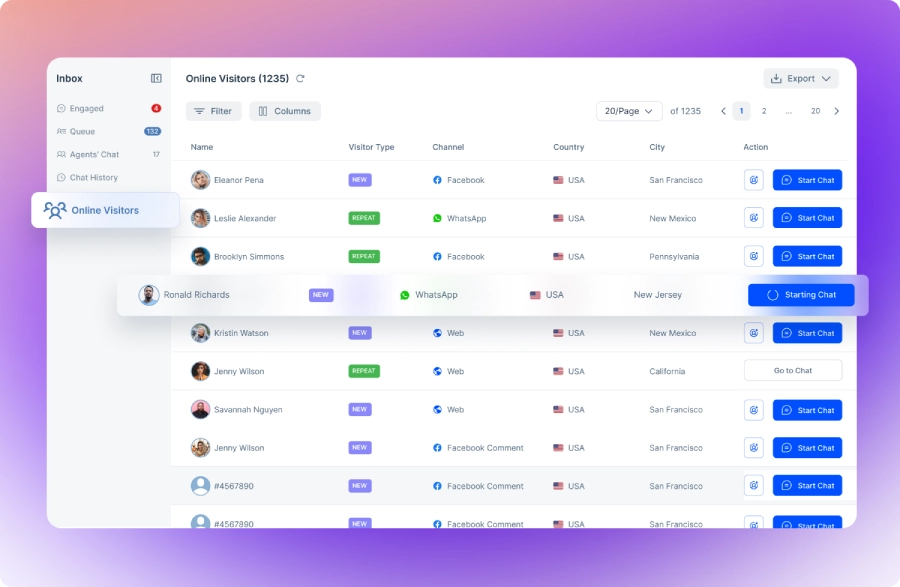
When you initiate a chat, you can message them proactively based on what they are viewing right now. Below is an example of chatting with a visitor who is having trouble deciding on a plan and you decided to proactively message them to guide them to a package.
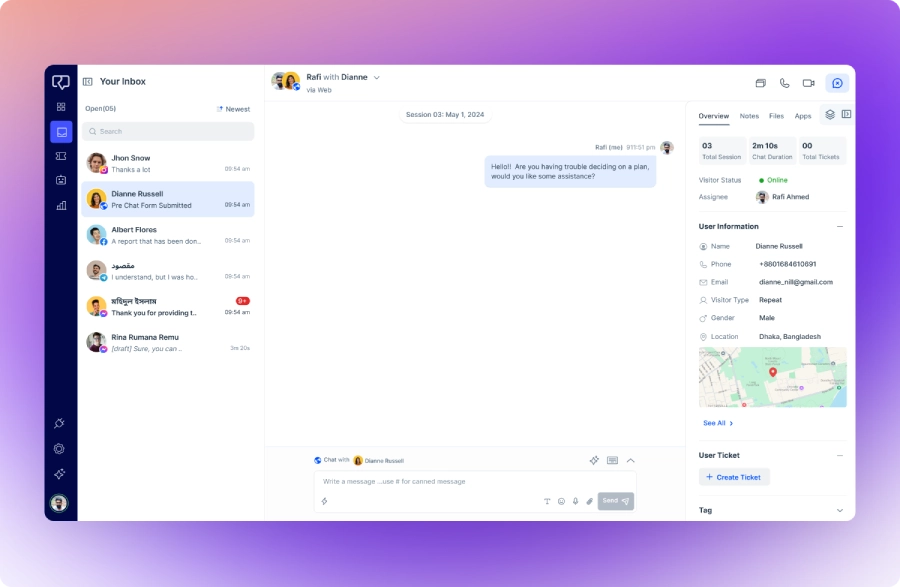
Through this simple and detailed system, you can guide users to what they want proactively while keeping them engaged on your platforms.
Conclusion
Utilizing proactive chats can improve your business in terms of sales, leads, and revenue while increasing your customers’ satisfaction rate. Understanding the nuances of proactive chat, identifying triggers, and following best practices is a great way to use such a technique effective.
To make use of proactive live chat, you can use of a tool like REVE Chat, that is designed to contribute to customer service through a live chat solution. Thus, using the right tool and following the right guidelines will ensure that your business succeeds and your customers are happy.


